Scientific Facts
| Common Name: | Swamp rabbit, marsh rabbit, cane-cutter |
| Scientific Name: | Sylvilagus aquaticus |
| Life Span: | 9 years in the wild |
| Size (Adult): | 17.8 inches |
| Weight (Adult) | 4 pounds |
| Habitat: | Swamps, wetlands |
| Body Shape: | Large |
| Country of Origin: | The South-central United States and the Gulf Coast |
Physical Description

The swamp rabbit or swamp hare is a large species of cottontail rabbit native to the swamps and wetlands in areas south of the United States. It is also known as a marsh rabbit and cane-cutter. Unlike common rabbits that prefer dry and grassy areas, the swamp rabbit loves to swim and take to the water to play and look for food.
The swamp rabbit is known as the largest of its cottontail relatives, but its ears are smaller compared to its family members. Males are slightly larger compared to their female counterparts. The head and the back are dark or brown. The throat, tail, and ventral surface are white. There is a distinct cinnamon-color around its eyes.
The sides of the swamp rabbit, as well as its tail, rump, and feet, have darker coloration than the rest of its body. It shares many similarities to the eastern cottontail when it comes to appearance, but the eastern cottontail has whitish eye-rings.
This rabbit is large; males can vary in weight from 4 to 5.6 pounds, with an average of 5 pounds. Females are 3.6 to 5.9 pounds, with an average of 4.8 pounds. Length varies as well from 17.8 to 21.7 inches, with an average of 19.7 inches.
Fast Facts
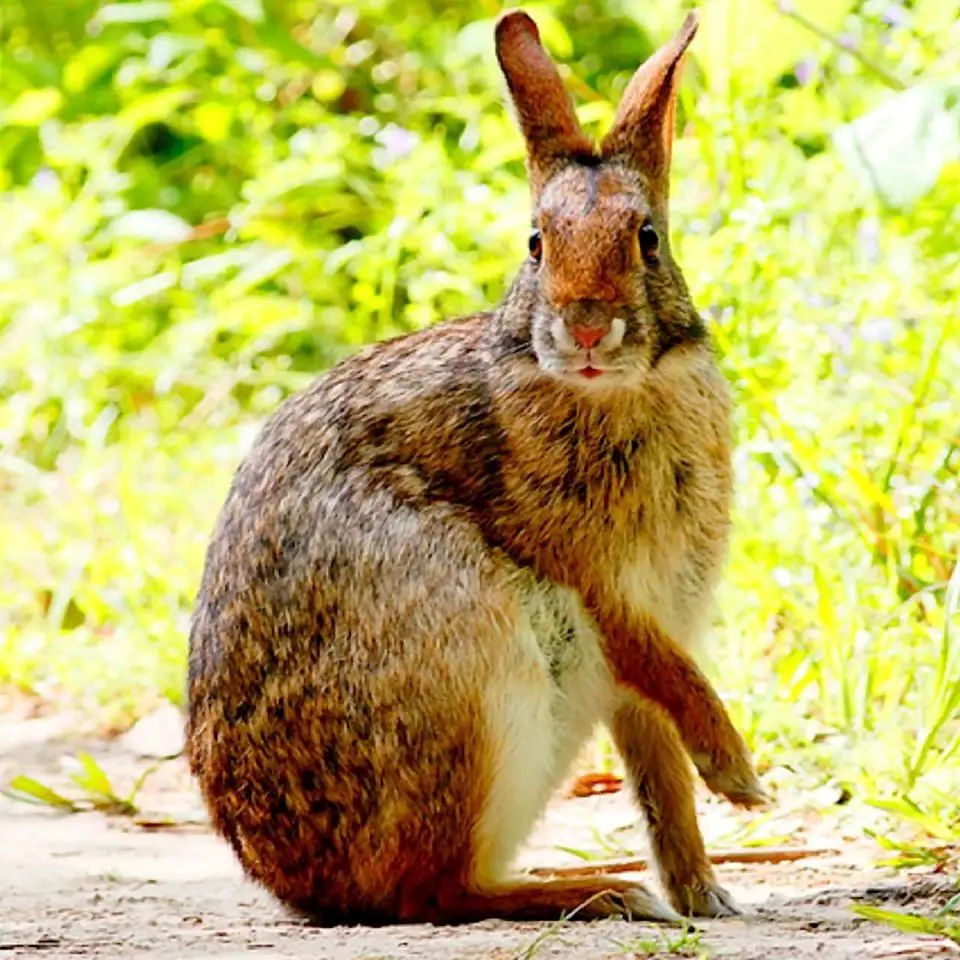
Swamp rabbits are usually energetic at night when they prefer to forage for food. They are herbivores, so will eat the only tree and plant parts. Despite their close affinity to water, they don’t eat fish or small crustaceans.
Male swamp rabbits can fight other males to death. This happens as they fight for territory. The males can become very aggressive and violent, and when fighting, they will stand on their hind legs to make them look bigger. They have several ways to attack a rival, and these will be discussed in rabbit behavior.
Swamp rabbits are wild rabbits and should not be taken from the wild and cared for in a home. But if for whatever reason you were able to take care of a swamp rabbit, you can take care of it just like any other rabbit species but with a few important considerations.
Also, it’s better to adopt a swamp rabbit or any kind of rabbit from a rescue instead of getting one from the wild.
Temperament
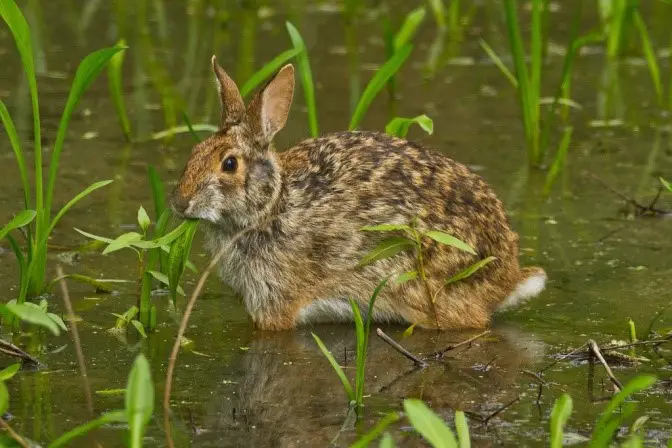
As mentioned, the swamp rabbit is most active during nighttime, from dawn and dusk. During the day, they hide or remain motionless inside a hollow log or dense grass. These will move only when there is a predator; otherwise, they still and in a sleepy-trance like an appearance.
When a predator spots them and gets too close, this rabbit can easily sense it and springs into action right away. It flees the scene in a zigzag pattern. This is a way for cottontails to lose its predator; their scents are easily lost in the air as they move quickly from side to side. These rabbits will jump into the water and remain very still sometimes with just their noses above the water surface. This impressive way to escape predators is similar to the eastern cottontail, but the swamp rabbit can hide underwater.
A linear dominance hierarchy exists among males within a population. This behavior limits fighting among males once the dominant male is established in the group. Experts notice that males are more aggressive during the breeding season.
Males will actively pursue females in the hopes of wooing her and getting her to mate. Often, males would challenge each other by standing on their hind legs and using their sharp claws and teeth to wound their opponent. Male rabbits suffer from severe injuries during these aggressive fights, and sometimes the injuries can be too severe that these can cause death. Males can also jump at each other from the ground and strike using the claws of their hind feet. The injury inflicted by their sharp hind claws and strong hind feet would be enough to kill an opponent.
Meanwhile, female swamp rabbits may exist in mutual tolerance. This means that they rarely engage in fights and will remain friendly at each other throughout the year. Females engage in a ritual mating dance or jumping. While males woo females by stalking them and cornering them, females try to move away by threatening and chasing the males. The males will jump away when the females do this but will soon return. This behavior will continuously happen until the male has finally mated with the female.
Swamp rabbit is known to be synchronous breeders, which means all the members of a group of rabbits will breed at the same time. More about rabbit breeding in the next sections.
Some of these wild behaviors are also present in captive-bred swamp rabbits. Keeping two males in one enclosure can lead to aggression, especially during the breeding season. But for the rest of the year, males remain calm and social.
Reproduction in the wild

Males are larger than females. Swamp rabbits breed simultaneously in one area. But before breeding happens, predictable mating behavior can be noticed in males and females. First, the females chase or threaten males, and males respond by dashing away. They engage in a jumping sequence, and after a while, females give in, and copulation happens. Afterward, females will soon chase the males again.
The breeding season is from the middle to late February to August. There are some areas in the US with a different swamp rabbit breeding season. In Texas, breeding happens all year round while in Louisiana, breeding may happen every month except for October.
Unbred females undergo an estrous behavior after a 12-day cycle and can last for an hour. The gestation period lasts up to 40 days, with an average of 37 days. Swamp rabbit females will give birth to live young from 1 to 6 babies and an average of 3 babies in one litter.
Before they give birth, females use grass, twigs, leave, and soil to create their nests. These are comfortable nests which are 5.5 cm deep, 18 cm high and 15 cm wide with side entrances. They may also utilize holes in hollow tree trunks as nests. Females may also construct fake nests to fool their predators. Finally, they will line these nests with fur the last minute before they give birth.
As soon as the female gives birth, she will remain with her young until the time that they leave the nest. Newborns open their eyes after four to seven days. These will leave the nest after two weeks.
Swamp rabbits reach their sexual maturity after just 23 to 30 weeks. Juveniles may be able to breed during their first year of life, but despite this, most swamp rabbit juveniles prefer to breed later. Females can lay up to 6 litters a year.
Diet in the Wild
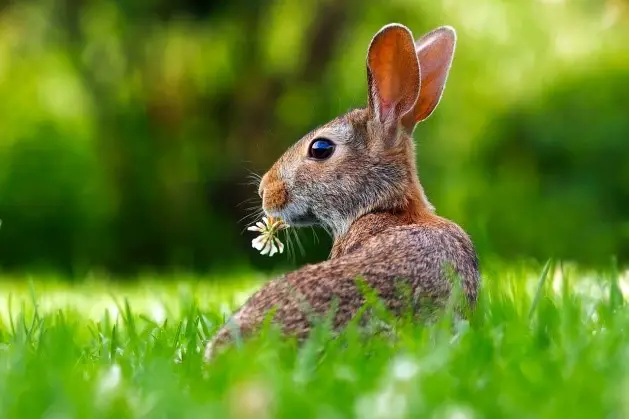
Swamp rabbits are herbivores. They will eat a variety of foraged plants such as grasses, shrubs, sedges, seedlings, and twigs. They prefer to look for food at night; however, weather conditions like rain during the evening may cause them to look for food and feed in the morning as well.
Swamp rabbits have preferred foods like savannah panicgrass, false nettle, greenbrier, and dewberry; swamp rabbits are lagomorphs, which means they have double digestion. Food is passed through its gut twice. First, the stool is soft and green, which still contains nutrients. The rabbit eats this, and after digestion, a drier and darker feces are passed. These have no more nutritional content, and thus, the rabbit does not eat this anymore.
Natural Habitats and Homes
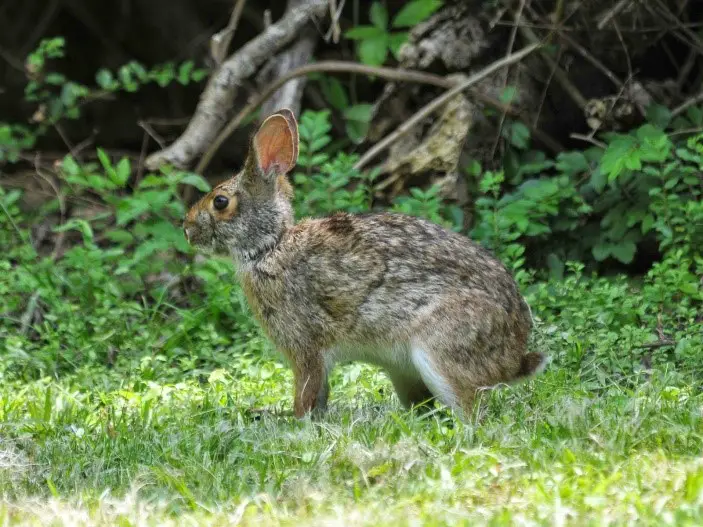
The swamp rabbit lives in the south-central United States and on the Gulf Coast. You’ll find large numbers of swamp rabbits in the US states Alabama, Louisiana, Mississippi, and South Carolina. This large cottontail species is also present in Tennessee, Oklahoma, Texas, Arkansas, Missouri, Kentucky, Kansas, Illinois, Indiana, and Georgia.
This rabbit prefers to stay near lowland water and usually where food is readily accessible. It can thrive in marshlands, cypress swamps, floodplains, and river tributaries. Swamp rabbits remain in depressions where they use their claws to dig in tall leaves and grasses. They hide effectively under tall grass to wait until its dark enough to forage.
Lately, there is a concern that swamp rabbits are becoming more exposed to predation, especially during the cold winter/snowy months. Snow cover may increase the mortality of swamp rabbits since snow hides their food resources.
Within their natural habitat are predators as well. Swamp rabbits are prey to domestic dogs, American alligators, and even humans. Swamp rabbits may not be able to swim well, and hence, they can’t count on their swimming speeds to outrun dogs and other water predators. But, they can remain in the water, lying still as a dead log. They can remain in the water surrounded by plant debris and brush with just their noses visible above water.
Swamp rabbits are also the second-most commonly hunted species of rabbits in the United States. And to escape predators, the swamp rabbit uses techniques like irregular jumping, freezing, or staying very still and cryptic coloration. The fur color of the swamp rabbit allows them to blend with the forest or swamp color. It’s hard to spot a swamp rabbit even if it’s just a few feet in front of you.
Roles in the Ecosystem
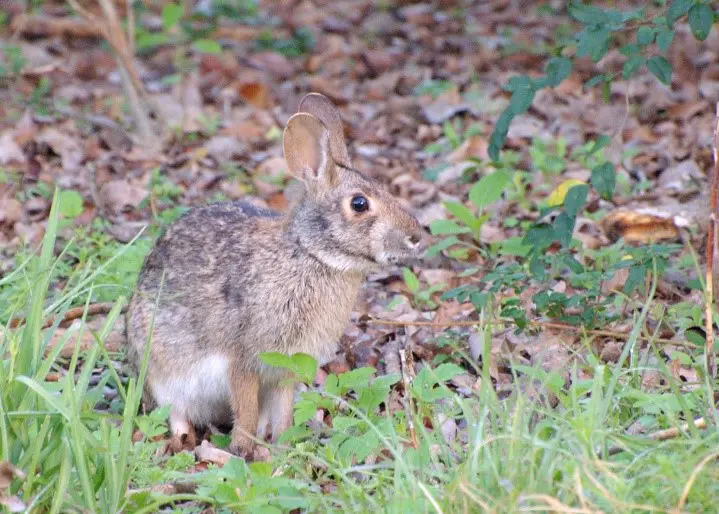
Swamp rabbits are very important prey in the ecosystems. These also have herbivory influences in plant communities. Swamp rabbits are also affected by many parasites such as trematodes, cestodes, nematodes, ticks, fleas, and mites. Because of these parasites, it is not recommended to take a swamp rabbit from the wild to become pets.
Swamp rabbits are hunted for their fur, meat, and also for sport. Their body parts are a source of various materials. These rabbits may also have a negative impact on humans as they can grow in large numbers in an area and damage crops as well as other vegetation.
Fun Facts

President Jimmy Carter has encountered a swamp rabbit during one of its hunting and fishing activities in Georgia. It was 1979 when a swamp rabbit was being chased by hounds in the swamplands of Georgia. The rabbit instinctively dived in the water to avoid being chased by predators. The rabbit swam near the boat of President Carter, but he shooed the creature away by splashing water using his paddle.
As you may have known, the swamp rabbit is abundant in many US states, but lately, states like Missouri and Oklahoma are reported to have diminishing populations. Experts believed that this is due to the loss of wetland areas where swamp rabbits live and degradation.
Personality
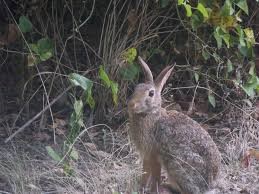
In the wild, swamp rabbits are skittish, very attentive, and careful. They are very aware of their vulnerability as prey, and they do all they can to hide from their natural enemies. They cannot be petted or will never approach a human. If you are in a campsite where the swamp rabbit lives nearby, it can check you out by moving curiously near the site, but it will never confront humans directly.
These are voracious eaters, so they may forage for food all night if they can. Also, they may look for food in human homes and yards. It is not uncommon for swamp rabbits to wander into human areas to steal food, crops, and material.
But once a swamp rabbit is used to humans, it will come back to get more food, especially at night.
Meanwhile, captive-bred rabbits are calmer, more docile, and less skittish. If they perceive no threats, they can warm up to their owners slowly using treats and rewards. Swamp rabbits can remain as good pets as long as you interact with them regularly.
Care of Captive-Bred Swamp Rabbits
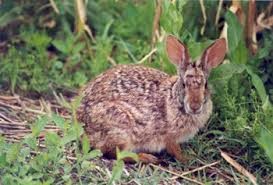
As mentioned earlier, we do not recommend taking a wild swamp rabbit and caring for it like a pet in your home. This breed is impossible to train and handle. It can also cause damage to your home if it breeds and multiplies. So these tips and techniques are also for captive-bred specimens but still be very careful and don’t overlook the dangers of caring for a pet rabbit.
Caring for a pet, captive-bred swamp rabbit is similar to how you care for other breeds. You must make sure that it has the correct diet, housing, companionship, and always take it to a vet for proper medical treatment.
The main food of captive-bred rabbits like the swamp rabbit is hay. Hay is the bulk of their diet, so they can chew this all day long if they can. You may also use pellets designed specifically for rabbits that have additional needed vitamins and minerals to their diets. You can include vegetables and fruits to create a well-rounded rabbit diet. Offer food found in their natural habitat as well as grasses, twigs, birch, the bark of brambles, maple trees, and weeds.
Always provide unlimited fresh water and hay. Hay is rough and is very helpful in keeping their digestive tracts healthy and regular. Place the water in a large, heavy shallow dish so that your rabbit can easily drink from it. A heavy dish is important, so your rabbit won’t knock it over. You may also place water in a container with a spout.
Water is a vital part of a swamp rabbit’s life, so it would be a good thing to construct a shallow pool inside the enclosure. Construct an outdoor enclosure instead of an indoor one, so your pet has a lot of room to roam.
Captive-bred Swamp rabbits can become a lovable pet, but it can take time to train it. Interact by playing with your pets every day. Rabbits are social animals, and aside from interacting with their fellow rabbits, these also need human interaction. Captive-bred rabbits thrive well because they interact with their owners every day.
Spaying or Neutering
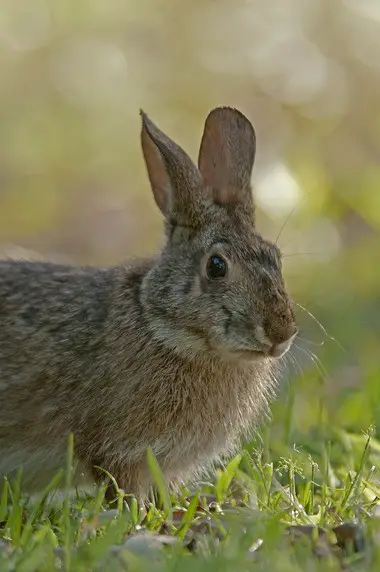
Spaying and neutering control the population of swamp rabbits and other rabbit species. Because of the promiscuity of swamp rabbits, you must control their ability to breed if you want to keep these rabbits in your home.
Spaying and neutering are done while your rabbits are still at a young age. However, some veterinarians wait until the rabbits are in their sixth month to be on the safe side. Bucks are also neutered at a young age or as young as three months to make them less aggressive. Consult a vet on the best practice for spaying and neutering your pet.
Supplies and Cages
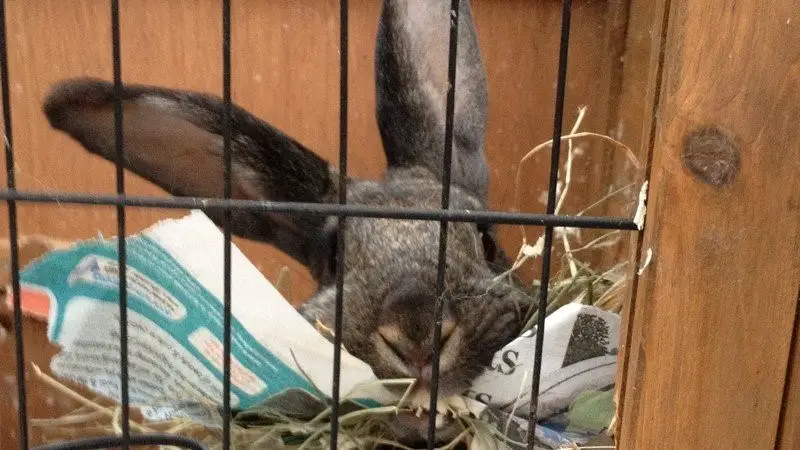
The home for captive swamp rabbits should have a wire enclosure and a removable plastic bottom; this is where the droppings fall, so it is easier to remove the bottom for maintenance. The floor of the cage must have soft bedding so that it is comfortable for your rabbit to stay on.
You can place a rabbit hay feeder on the side of the enclosure where your rabbit can eat when they feel hungry. For the bedding, you may use aspen, wood pellets, or pelleted horse bedding. You may clean the cage using a safe cleaner or natural cleaning products like white vinegar, baking soda, or lemon. Avoid bathroom or common household cleaners, which may be toxic for rabbits.
Everyday spot cleaning is recommended. Rabbits will eat their poop, so you need to remove these as soon as you see one. Replace the bedding regularly or at least every week. This will remove any annoying smells.
Swamp rabbits will groom themselves. Sometimes a rabbit can take hours cleaning itself from head to toe taking extra time cleaning under the feet and ears. Rabbits grooming each other may be a social behavior as a way to bond with other rabbits. Mother rabbits may also groom their young while they are still in the nest.
Swamp rabbits are crepuscular, but some are also nocturnal, which means that they can be active in the daytime and even in the evenings. Their feedings should be done in the evening. Captive rabbits sleep 8 hours a day, on average, and they may sleep, huddled together keep warm.
Also, baby swamp rabbits are born without fur and with their eyes closed. If you want to breed captive swamp rabbits, place the baby rabbits in a warm enclosure or container to keep their bodies at the right temperatures.
Indoor vs. Outdoor Cage

A common question for first-time rabbit owners is where to put the cage in. Consider the pros and cons of indoor and outdoor rabbit enclosures. Rabbits that live indoors have longer lives and are more social and happier. Their cages will be nearby, and so you can easily take one from their cage and pet them or play with them. Interaction with their owners is very important in caring for any type of rabbit.
Meanwhile, rabbits that live outdoors are usually skittish and may not bond with their owners because you may rarely take them out of their cage to train or play with them. Captive rabbits that are kept in outdoor enclosures are also vulnerable to weather changes, temperature extremes, parasites like mites, ticks, and fleas, and other complications. Consider these if you live in an area where climate and weather changes are to the extreme.
If you want to keep your rabbits inside, but do not have enough space, you can prepare an outdoor cage where your rabbits can play and feed. Meanwhile, outdoor cages are the easiest to clean. An outdoor cage also gives your rabbits room for playing and running. Keep the rabbit cage away from direct sunlight and areas with high moisture. The cage must also be well-protected from predators. Despite its size, swamp rabbits may be prey to other pets such as cats and dogs. You can’t check on your rabbits as often as possible, but they will have a lot of space that mimics their natural environment.
Health Concerns
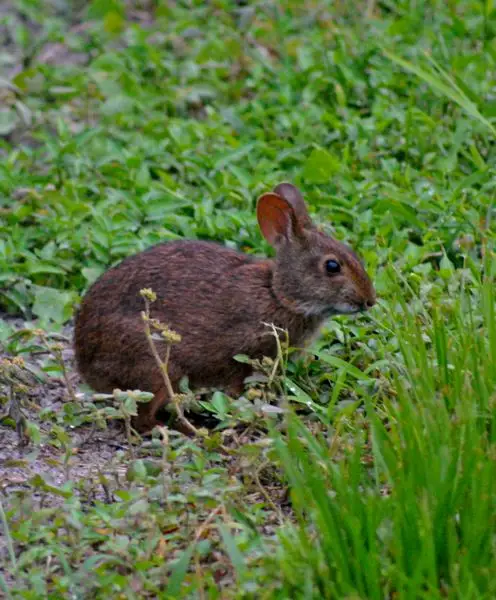
Swamp rabbit is a very hardy rabbit breed and is not in any way affected by the disease in their natural environment. The most that swamp rabbits may be affected with are pests like nematodes, cestodes, mites, ticks, and fleas because these are pests that are naturally found in their environment.
Meanwhile, captive rabbits are not immune to common rabbit diseases. With this in mind, you must always be mindful of your rabbit’s state of health and overall temperament. Any change may be possible signs of illnesses.
Take your rabbit to a vet for standard vaccinations and tests that can help assess the overall health and development of your pet. Some rabbit breeds have sensitive digestive systems and may be more prone to different health conditions of the digestive system.
For this, you must have your rabbits checked against enteritis, bloat, and stasis, which are important in rabbits that are less than two months old. Always check for ear or fur parasites like mites, fleas, and ticks. Most of the time, rabbits with these pests suffer from poor hygiene, poor husbandry, and poor animal management.
Be on the lookout for signs of illness like poor appetite, nasal and eye discharges, diarrhea, and vomiting. Rabbits with an unsteady gait, restlessness, grating of the teeth, and sleepiness should receive medical attention right away.
De-worming is also recommended for swamp rabbits. This is a major concern, especially with rabbits that are taken from the wild or are bred from wild parents. All rabbit breeds should be dewormed, and this should be done in the spring and fall. You can use a pea-sized amount of de-worming paste and put it in the rabbit’s mouth. Follow the dose according to the product container to get the best results.
Teeth
An important part of taking care of a rabbit’s health is caring for its teeth. This rabbit needs regular check-ups because their teeth tend to grow very fast. But dental health begins at home. You must make sure that the rabbit’s teeth won’t overgrow.
Rabbits chew so much because if they don’t, their teeth tend to grow very long. When this happens, their teeth can grow right into the rabbit’s mouth and jaws, which causes extreme pain.
You can also help trim the rabbit’s teeth by offering a diet high in hay as it files down the rabbit’s teeth naturally while they chew. Keep an eye on your rabbit’s dental health, so you can save yourself from expensive medical and dental bills.
Grooming
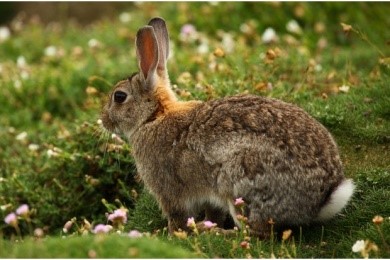
Swamp rabbits have short fur but will need regular grooming as well. You need to brush the fur to keep their coats clean, shiny, and pest-free. You must groom it with a small brush at least weekly. You must groom more frequently during their molting period, to prevent wool blocks and fur ingestion. Fur can accumulate in the digestive tract causing blockage and may more complications.
Even if your rabbit is very dirty, you should never bath it because doing so can stress them. You can use a damp towel to spot clean. Just wipe the rabbit down with the towel and use a dry towel to dry off. Trim their nails monthly and also check for overgrown teeth. Ask the vet to do this for you if you don’t have nail trimmers or if you’re not comfortable with cutting your rabbit’s nails. The rabbit’s big ears should also be checked and cleaned.
Breeding

Breeding captive swamp rabbits are easy because these rabbits may breed all year long. It’s also easy to stimulate breeding in this species of rabbits because males are not very choosy when selecting his mate. In captivity, leave a male and female inside a large cage or enclosure. You need a large cage in case the rabbits start their ritual jumping dance.
The female may start to look unimpressed with the male, but soon, she will give in and start to mate. Mating happens quickly, and soon, you will notice that the female is disinterested in eating and playing and will seem unattached with the male. A bump on her belly will indicate that the rabbit is indeed pregnant. You may also ask your vet to conduct a pregnancy if you want to make sure.
Once the female is ready to give birth, it will now start to look for a good place to lay her babies. Remove the male and provide fresh grass, twigs, and leaves so that the female can build her nest. She will finish it just in time for her contractions.
The female will give birth to one to four babies and can give birth three times or more in a breeding season. The newborns are completely helpless and are born with their eyes shut. They will open their eyes after a few days. Remove these from the nest and protect them under strong lighting and offer the right kind of food.
Other Notes
Just like other breeds, captive swamp rabbits love chewing on things. If kept indoors, these will chew on wooden furniture, and even electrical wiring. To avoid these potential accidents, provide hay or chew toys aside from their food.
Also, protect your rabbit from the effects of pesticides, toxins, and herbicides. Younger rabbits may need alfalfa hay because this is rich in calcium, which is needed for growing bones. The adult swamp rabbits will eat legume hay. Be careful about giving just any yard clippings.
Just like any rabbit, swamp rabbits must be kept in pairs for companionship. Experts say that being with another rabbit will make it happier even in captivity and may help the rabbit live longer.
Availability – Where to Get One
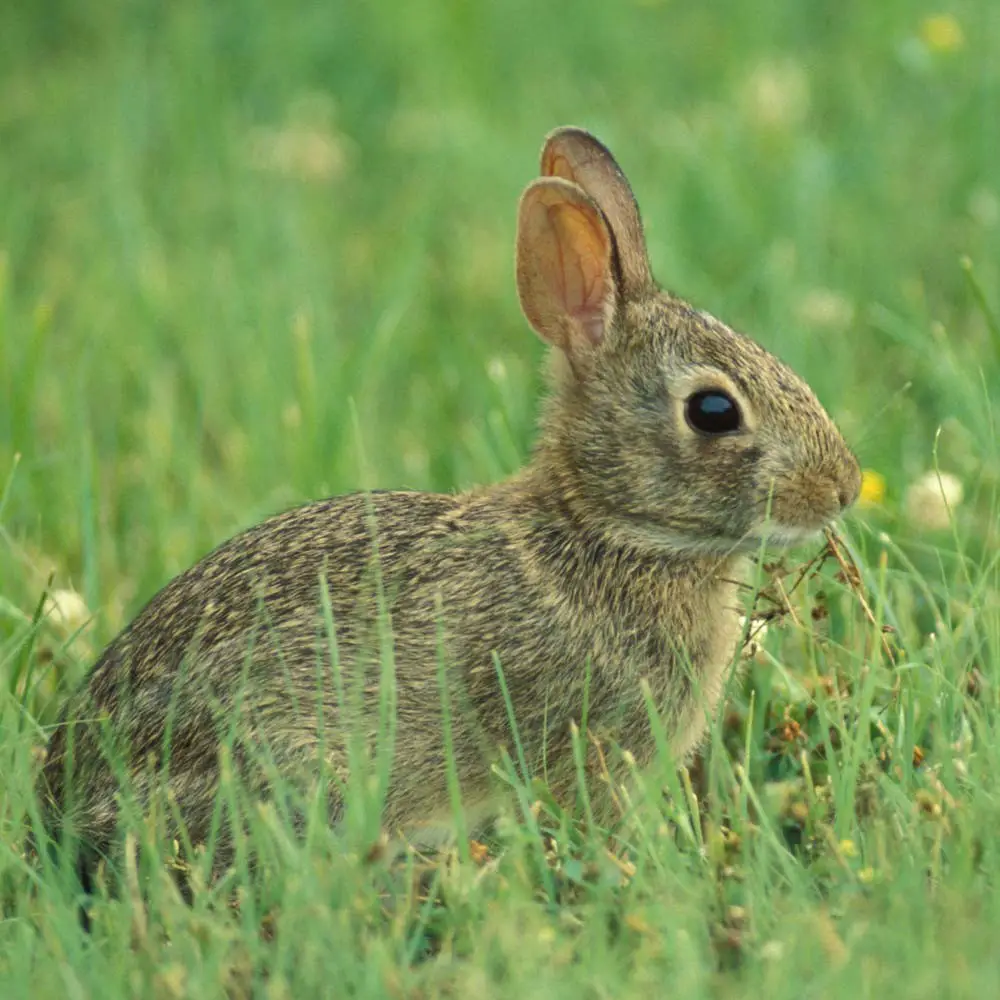
The cost of purchasing a swamp rabbit depends on whether you are getting it from a breeder or a retailer. The price may depend on whether you are getting a rabbit for a pet or breeding.
When looking for a reliable breeder, make sure that you are getting a healthy rabbit and not one with genetic disorders. You must buy only from reliable breeders who raise captive-bred swamp rabbits. Swamp rabbits are not bred for the show, but sometimes you may see this species in trade fairs and farm events to showcase large and healthy rabbits for their coat and meat.
How to Care for a Swamp rabbit
Caring for a pet, captive-bred swamp rabbit is just like caring for other rabbit breeds. You must make sure that it has the correct diet, housing, companionship, and, as much as possible, take it to a vet for proper medical treatment and preventive care.
The main food of captive-bred rabbits is hay. Hay is important in their diet, so they can chew this all day long. You may also use pellets specifically made for rabbits, vegetables, and fruits to create a well-rounded diet. You must also offer food found in their natural habitats like grasses, twigs, birch, the bark of brambles, maple trees, and weeds.
Always leave fresh water and hay inside the rabbit’s cage. Hay is rough and is very helpful in keeping their digestive tracts healthy and regular. Put the water in a large, heavy shallow dish so that your rabbit can drink from it.
Also, take note that water is a vital part of a swamp rabbit’s life. Construct a shallow pool inside the enclosure. Keep this water clean at all times and include pool wall cleaning as a part of the cage maintenance. If you’re debating as to an indoor or outdoor enclosure is better. But we recommend constructing an outdoor enclosure instead of an indoor one so the swamp rabbit can have room to play and run about.
Remember that captive-bred swamp rabbits can become a good pet, but it can take time to train it. It will help a lot if you interact by playing with your pets daily. Captive rabbits are social animals, and aside from interacting with other rabbits, these also need human interaction. Captive-bred rabbits can live longer and may thrive well when cared for by a handler.
FAQs
What do swamp rabbits eat?
Swamp rabbits are herbivorous, which means that they will only eat plants. They will eat all plant parts from roots to fruits, and they will also eat seeds, weeds, flowers, and tree bark.
Can swamp rabbits swim?
Yes, swamp rabbits can swim but not as good as other swimming mammals. But the most impressive water technique that swamp rabbits do is that they can completely submerge in water with only their noses seen on the surface of the water. They do this to escape predators.
Why do rabbits jump away in a crisscrossed manner?
Swamp rabbits can be seen jumping away from predators in a crisscrossed manner. They do this to scatter their scent in the air and confuse their predators. You may also see them jumping into the water to escape predators, as well.
How do you tame a swamp rabbit?
We don’t recommend petting and taming a swamp rabbit in the wild because this won’t be tamed at all. You can handle a captive-bred swamp rabbit instead; these rabbits still need constant handling, playing, and activity with their handlers so they will remain tame and happy in captivity.
Should you pick up a swamp rabbit from the forest?
No, don’t ever pick a wild animal like a swamp rabbit from the forest. You can’t tame it, and you won’t be able to take it home for a pet. If you spot an injured swamp rabbit and you would like to help, call animal services to help it out.
Are swamp rabbits endangered?
No, swamp rabbits are not endangered. These rabbits are present in large numbers in many states in the US.
Where do swamp rabbits live?
Swamp rabbits live in swampy, forested areas near the water. This is the largest cottontail rabbits and is also one of the largest specimens. They will spend time in the water as much as they can and will also visit foraging areas in the evenings.
Can you keep a swamp rabbit as a pet?
Only captive-bred swamp rabbits may be kept as a pet because these are, pre timid and hence safer to keep.
Can swamp rabbits eat meat?
No, these rabbits are herbivores, which means that these won’t eat any meat, only plants or plant parts. Swamp rabbits will eat tree parts like roots, bark, twigs, stems, leaves, flowers, seeds, and more.
Do swamp rabbits eat fruits and vegetables?
Yes, you can give captive pet swamp rabbits some fruits and vegetables. These rabbits will also eat commercially-prepared pellets or rabbit food.
Do swamp rabbits need water to swim in?
Yes, swamp rabbits need water where they can swim in. You must consider placing a shallow pool inside their enclosure to mimic their natural environment.
How do you clean a swamp rabbit’s cage?
First, remove the rabbit and place it in another smaller cage. Now, use a hose and some cleaning products and clean the cage walls, bottom, inside accessories, and toys.
Will swamp rabbits eat their poop?
Yes, swamp rabbits can eat their poop because these still have nutrients in them. But once they poop again, these won’t be eaten anymore.
Can you prevent a swamp rabbit from eating his poop?
You can stop it from eating poop by removing his droppings right away. But no matter what you do, these animals will still eat their droppings.
Do you need to place a heater inside a swamp rabbit’s cage?
In cold places, you can use a rabbit cage lamp to provide heat. But in extremely cold weather, you may use a small portable heater and just place this near the rabbit cage to create a comfortable place for your pet to live in.
Do you keep a swamp rabbit’s cage indoors or outdoors?
This may depend on you. You can place the cage of your pet indoors so these may be protected from the elements, but most indoor cages are small and may not be enough to hold a swamp rabbit. When you use an outdoor cage, the rabbits may need to bear the cold weather, but at least rabbits may have a large area to play and run around.
How large should a swamp rabbit’s cage be?
One swamp rabbit should be kept in an enclosure that’s at least 5 x 5 x 5 feet. For two rabbits, double this measurement. Always make sure that your rabbits have enough space to live comfortably.
Can you keep two or more swamp rabbits inside a cage?
You can keep two or more rabbits in one cage as long as the cage or enclosure is large enough to keep your pets in.
Are swamp rabbits territorial?
Experts say that swamp rabbits can be territorial when kept in a small enclosure. Males can become very aggressive to other males when it comes to breeding. They may bite, scratch, and kick their opponents to establish hierarchy and will also fight with other males to the death if necessary.
Will a mother swamp rabbit eat her young?
Some rabbit species will eat their young, and breeders are still unsure why the mother rabbit does this. If you spot the mother swamp rabbit eating her young in captivity, remove it from the litter or nest and never use it for breeding again.
How do you take care of baby swamp rabbits?
If you’re breeding baby swamp rabbits or you rescued babies from the wild, place these in a comfortable and warm place where they can sleep. Feed them soft, pureed food and keep them warm always. For wild-caught bunnies, call animal services to have these rescued properly. Baby swamp rabbits usually leave their nest after two weeks.
Can swamp rabbits survive the cold?
Yes, swamp rabbits can stay up in the cold and survive by foraging on food that’s underneath the snow. Swamp rabbits can dig underneath snow and eat unfrozen roots, shrubs, berries, and other edible morsels of food that they will find.
Can swamp rabbits remain outdoors?
If you have a pet swamp rabbit, you may allow these to remain outdoors, but you must rabbit-proof your yard first. You may also use a portable perimeter fencing to limit the area where the rabbit can go. But make sure to bury the poles well to prevent the rabbit from escaping.
Do you leave a swamp rabbits indoors out of its cage?
Just like allowing the rabbit to stay outdoors out of its cage, you may allow a rabbit to stay indoors but with your constant supervision. Again, use the portable perimeter fencing to fence off areas that the rabbit can go. Also, before allowing the rabbit to play indoors, rabbit-proof your home.
Are swamp rabbits able to climb up their cages?
No, swamp rabbits can’t jump or climb their cages, but these are strong enough to knock it down. Large swamp rabbit species are known to be very good kickers and hence can kick their cages or fences down to escape.
Do swamp rabbits have good hearing?
Although the swamp rabbit has smaller ears compared to the eastern cottontail, this rabbit also has a champion hearing. It can hear its predators from far away, and hence, it has time to jump away and escape.
Can swamp rabbits see well in the dark?
Yes, swamp rabbits have an amazing vision at night. This is why they prefer to forage for food at night. Rabbits like the swam rabbit also have a good sense of smell and hearing to allow them to detect predators nearby. Early detection of predators can help them escape faster.
Why do swamp rabbits jump?
Swamp rabbits jump for many reasons. One, they use this technique to fight for dominance as they stand on their hind legs and jump higher than other rabbits. They will also jump in a crisscrossed pattern to scatter their scent and fool their predators.
Does it hurt when a swamp rabbit hits you with its hind legs?
Yes, many people can attest to this because swamp rabbits have very sharp claws, even claws from its hind feet. Also, it can kick very hard using its hind feet, which can inflict so much damage. The rabbit will do this if it feels threatened, as a last resort to escape from predators.
Are swamp rabbits bites dangerous?
Yes, swamp rabbit bites from the wild are dangerous because these may have rabies. Not only this, their teeth are huge, and this can easily tear off flesh leaving you with a deep, open wound.
What happens when the teeth of swamp rabbits grow longer?
As the teeth of the rabbit grow longer, this can be too long to keep inside its mouth, and this can pierce its mouth and lower gums, causing too much pain. This is why your pet rabbits, as well as swamp rabbits, should visit the dentist regularly. You can also offer hay for the rabbit to chew on since this can help grind their teeth shorter.
How often do rabbits need to go to the vet?
Rabbits need to get vaccinated against some diseases, so they need to get an initial visit to a vet during the first weeks of their life. The vet will decide when the next visit will be according to his examination of your pet.
Are rabbit diseases harmful to humans?
Some rabbit diseases will only affect rabbits, while some are harmful to humans as well. If your rabbit is sick, take it to the vet at once. Know the different signs of illnesses like poor appetite, sneezing, drooling, diarrhea, constipation, and changes in behavior; you should take it to the vet once you notice these symptoms.

